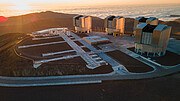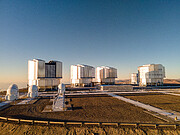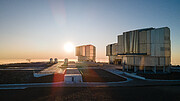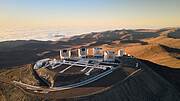Mitteilung
25 Jahre fantastische Wissenschaft und Ingenieurskunst am Very Large Telescope der ESO
25. Mai 2023
Das Very Large Telescope (VLT) der ESO, eines der modernsten optischen Teleskope der Welt, feiert heute sein 25-jähriges Bestehen. In den letzten zweieinhalb Jahrzehnten hat das VLT von seinem Standort in der chilenischen Atacama-Wüste aus unser Verständnis des Universums mit mehreren bemerkenswerten Premieren tiefgreifend beeinflusst.
Das VLT der ESO ist das Flaggschiff der europäischen bodengebundenen optischen Astronomie. Es besteht aus vier Hauptteleskopen mit Hauptspiegeln von 8,2 Metern Durchmesser und vier verfahrbaren 1,8-Meter-Hilfsteleskope, die Teil des VLT-Interferometers sind. Am 25. Mai 1998 lieferte das Hauptteleskop 1 (Antu) seine ersten Bilder und leitete damit eine neue Ära für die Astronomie ein.
Seitdem haben Astronomen mehr als 10.000 wissenschaftliche Arbeiten auf der Grundlage der von den VLT-Teleskopen gesammelten Daten verfasst, im Durchschnitt mehr als eine von Fachleuten begutachtete Arbeit pro Tag. Zu den wichtigsten Forschungsarbeiten, die mithilfe des VLT durchgeführt wurden, gehören die Untersuchung des supermassereichen Schwarzen Lochs im Zentrum der Milchstraße und der Nachweis der beschleunigten Expansion des Universums, die beide mit Nobelpreisen ausgezeichnet wurden. Weitere wichtige Ergebnisse sind die erste direkte Abbildung eines Planeten außerhalb unseres Sonnensystems und die Charakterisierung des ersten sichtbaren Gegenstücks zu einer Gravitationswellenquelle.
Die bemerkenswerten Beiträge des VLT zur Wissenschaft wurden durch eine Reihe modernster Instrumente ermöglicht. Eines der vielseitigsten und von der astronomischen Gemeinschaft am meisten nachgefragten Instrumente ist der FOcal Reducer and Low Dispersion Spectrograph (FORS), mit dem Bilder von relativ großen Himmelsbereichen mit sehr hoher Empfindlichkeit aufgenommen werden können. FORS hat in der Tat einige der berühmtesten astronomischen Bilder mit dem VLT aufgenommen. Ein weiteres vielseitiges Instrument ist der Multi Unit Spectroscopic Explorer (MUSE), ein leistungsstarker Spektrograf, mit dem Astronomen 3D-Ansichten des Universums erstellen können. Das VLT beherbergt auch den X-shooter, mit dem ein breites Spektrum an astronomischen Objekten beobachtet werden kann, von schwachen bis hin zu sehr hellen Objekten. GRAVITY, ein Instrument des VLT-Interferometers, ist ebenfalls besonders einzigartig, da es das Licht von vier Teleskopen zusammenführt und stabilisiert, sodass die Astronomen auch kleinste Details in sehr schwachen Objekten erkennen können.
Zusätzlich zu seinen vielseitigen Instrumenten verfügt das VLT über ein fortschrittliches Adaptives Optiksystem, das die durch atmosphärische Turbulenzen verursachten Unschärfen korrigiert. Das Vier-Laser-System, das am Hauptteleskop 4 (Yepun) installiert ist und zur Anregung von Natriumatomen in der Atmosphäre dient, ist vielleicht das sichtbarste Merkmal der Adaptiven Optik des VLT. Die von den Lasern angeregten Atome emittieren Licht, das von der Atmosphäre auf die gleiche Weise beeinflusst wird wie das von echten Sternen. Das emittierte Licht wird vom Teleskop aufgefangen und kann von der Adaptiven Optik verwendet werden, um die atmosphärischen Verzerrungen zu messen und zu korrigieren. Dieses ideenreiche System sorgt in Verbindung mit den ausgezeichneten Bedingungen eines dunklen Nachthimmels in der Atacama-Wüste dafür, dass das Teleskop extrem scharfe Bilder liefern kann.
Das VLT ist nach wie vor führend in Wissenschaft und Technik und wird voraussichtlich auch in den kommenden Jahren wichtige Entdeckungen machen. Eine laufende Verbesserung ist die Einführung eines Laserleitsterns an jedem der Hauptteleskope 1-3 als Teil der Aufrüstung des GRAVITY-Instruments.
Die ESO wird das VLT in dieser Woche auf ihren Social-Media-Kanälen feiern. Bleiben Sie dran für die neue ESO YouTube-Show: Chasing Starlight, die in ihrer ersten Folge einige der wichtigsten wissenschaftlichen Ergebnisse des VLT vorstellen wird.
Links
Kontaktinformationen
Markus Nielbock (Pressekontakt Deutschland)
ESO Science Outreach Network - Haus der Astronomie
Heidelberg, Deutschland
Tel: +49 6221 528-134
E-Mail: eson-germany@eso.org
Bárbara Ferreira
ESO Media Manager
Garching bei München, Germany
Tel: +49 89 3200 6670
Email: press@eso.org
Über die Mitteilung
| ID: | ann23009 |








